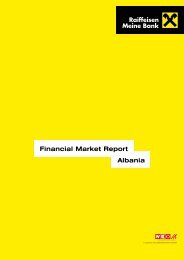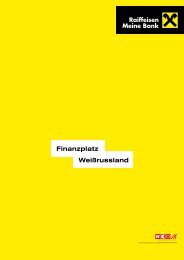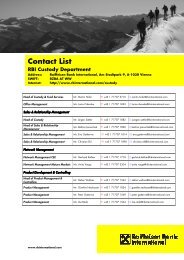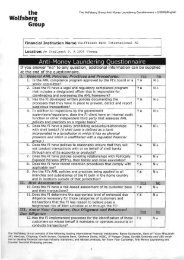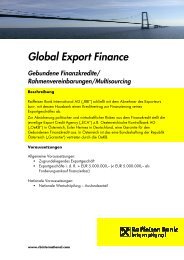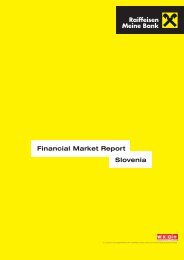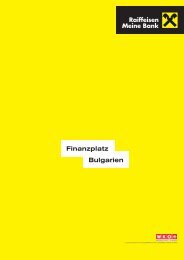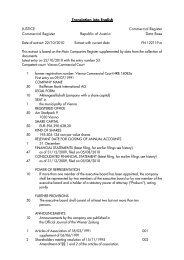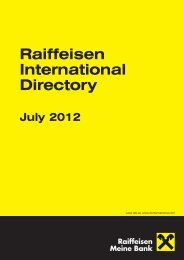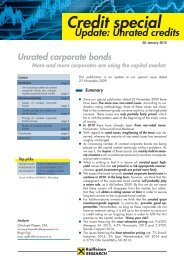Belarus - Raiffeisen Bank International AG
Belarus - Raiffeisen Bank International AG
Belarus - Raiffeisen Bank International AG
Create successful ePaper yourself
Turn your PDF publications into a flip-book with our unique Google optimized e-Paper software.
1. The Economic and Political<br />
Situation in <strong>Belarus</strong><br />
National Economy in Crisis<br />
4<br />
In contrast to developments in other CEE countries, the <strong>Belarus</strong> economy still remains largely in the hands<br />
of the state. About 75% of GDP was generated by state-owned companies, and state banks comprise 70%<br />
of the banking sector. <strong>Belarus</strong> experienced a strong phase of growth with an average rate of 7.5% p.a. in<br />
the five years leading up to the financial crisis. Both internal factors, such as high investments and climbing<br />
private consumer demand, and external factors such as strong demand for <strong>Belarus</strong>’s export goods,<br />
contributed significantly to this dynamic. Exports include petrochemical products for the European market<br />
(above all products from two oil refineries) and industrial facilities, trucks, tractors, consumer goods and<br />
food, which are sold in the post-Soviet area (especially in Russia). With foreign trade revenues (the sum of<br />
exports and imports) of over 100% of GDP, the country is a very open national economy.<br />
Politically, <strong>Belarus</strong> is associated with neighbouring Russia via membership in multiple organisations. In<br />
addition to the Commonwealth of Independent States (CIS), <strong>Belarus</strong> belongs to a union state with Russia<br />
that was founded in the 1990s (and does not function well), and the Eurasian Economic Area (EurAsEC),<br />
which is a customs union between Russia and Kazakhstan formed in 2010. The customs union currently<br />
has numerous deficiencies that should be addressed by a shared economic space as of 2012. In addition,<br />
<strong>Belarus</strong> profited, even before the introduction of the customs union, by preferential access to the Russian<br />
market and very favourable conditions for the delivery of oil and gas.<br />
Despite this reliance on Russia, President Alexander Lukashenko, who has been in office since 1994, has<br />
wanted to limit direct foreign political and economic influence on <strong>Belarus</strong>. The president’s authoritarian style<br />
of leadership, as well as the high percentage of state-owned companies, means that hardly any important<br />
economic decisions are taken without Lukashenko’s blessing.<br />
The <strong>Belarus</strong> economic model was based on cheap Russian energy in recent years, which increased the<br />
competitiveness of domestic industry and allowed the subsidisation of otherwise unprofitable sectors (such<br />
as agriculture). From 2007 forwards, however, Russia has slowly increased prices to bring them to world<br />
market levels. <strong>Belarus</strong> offset decreasing energy subsidies on one hand by striving to increase energy<br />
efficiency, and on the other by taking on more loans from abroad.<br />
The state’s strong control of the economy turned out to be a good thing during the financial and economic<br />
crisis of 2008/2009. Despite a massive collapse in exports, domestic investors were forced to avoid terminations,<br />
thereby stabilising private domestic demand. A currency devaluation and support from the<br />
<strong>International</strong> Monetary Fund (IMF) totalling over $ 3.6 billion successfully prevented a deep recession like<br />
those in the Ukraine or Russia.



